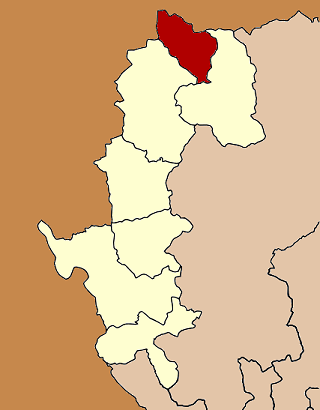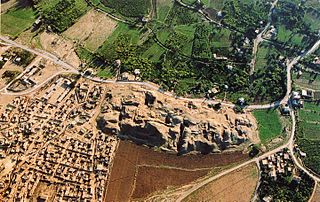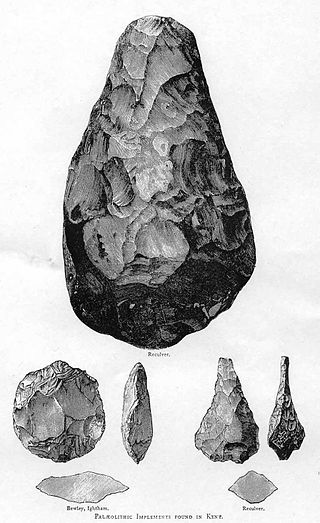
The Epipalaeolithic Near East designates the Epipalaeolithic in the prehistory of the Near East. It is the period after the Upper Palaeolithic and before the Neolithic, between approximately 20,000 and 10,000 years Before Present (BP). The people of the Epipalaeolithic were nomadic hunter-gatherers who generally lived in small, seasonal camps rather than permanent villages. They made sophisticated stone tools using microliths—small, finely-produced blades that were hafted in wooden implements. These are the primary artifacts by which archaeologists recognise and classify Epipalaeolithic sites.

The Neolithic or New Stone Age is an archaeological period, the final division of the Stone Age in Europe, Asia and Africa. It saw the Neolithic Revolution, a wide-ranging set of developments that appear to have arisen independently in several parts of the world. This "Neolithic package" included the introduction of farming, domestication of animals, and change from a hunter-gatherer lifestyle to one of settlement. The term 'Neolithic' was coined by Sir John Lubbock in 1865 as a refinement of the three-age system.

The 8th millennium BC spanned the years 8000 BC to 7001 BC. In chronological terms, it is the second full millennium of the current Holocene epoch and is entirely within the Pre-Pottery Neolithic B (PPNB) phase of the Early Neolithic. It is impossible to precisely date events that happened around the time of this millennium and all dates mentioned here are estimates mostly based on geological and anthropological analysis, or by radiometric dating.

Matriarchy is a social system in which women hold the primary power positions in roles of authority. In a broader sense it can also extend to moral authority, social privilege and control of property. While those definitions apply in general English, definitions specific to anthropology and feminism differ in some respects.

When God Was a Woman is the U.S. title of a 1976 book by sculptor and art historian Merlin Stone. It was published earlier in the United Kingdom as The Paradise Papers: The Suppression of Women's Rites. It has been translated into French as Quand Dieu était femme in 1978, into Dutch as Eens was God als Vrouw belichaamd – De onderdrukking van de riten van de vrouw in 1979, into German as Als Gott eine Frau war in 1989 and into Italian as Quando Dio era una donna in 2011.

The Goddess movement includes spiritual beliefs or practices that emerged predominantly in North America, Western Europe, Australia, and New Zealand in the 1970s. The movement grew as a reaction to Abrahamic religions, which have only gods with whom are referred by male pronouns, and it uses goddess worship and may include a focus on women or on one or more understandings of gender or femininity.

The First Sex is a 1971 book by the American librarian Elizabeth Gould Davis, considered part of the second wave of feminism. In the book, Gould Davis aimed to show that early human society consisted of matriarchal "queendoms" based around worship of the "Great Goddess", and characterised by pacifism and democracy. Gould Davis argued that the early matriarchal societies attained a high level of civilization, which was largely wiped out as a result of the "patriarchal revolution". She asserted that patriarchy introduced a new system of society, based on property rights rather than human rights, and worshipping a stern and vengeful male deity instead of the caring and nurturing Mother Goddess.
The Holocene calendar, also known as the Holocene Era or Human Era (HE), is a year numbering system that adds exactly 10,000 years to the currently dominant numbering scheme, placing its first year near the beginning of the Holocene geological epoch and the Neolithic Revolution, when humans shifted from a hunter-gatherer lifestyle to agriculture and fixed settlements. The current year by the Gregorian calendar, AD 2023, is 12023 HE in the Holocene calendar. The HE scheme was first proposed by Cesare Emiliani in 1993, though similar proposals to start a new calendar at the same date had been put forward decades earlier.

Spirit Cave is an archaeological site in Pang Mapha district, Mae Hong Son Province, northwestern Thailand. It was occupied 12,000 to 7,000 uncalibrated radiocarbon years ago by prehistoric humans of the Hoabinhian culture.

Prehistoric Korea is the era of human existence in the Korean Peninsula for which written records do not exist. It nonetheless constitutes the greatest segment of the Korean past and is the major object of study in the disciplines of archaeology, geology, and palaeontology.

Merlin Stone was an American author, artist and academic. She was an important thinker of the feminist theology and Goddess movements and is known for her book When God Was a Woman.

The Myth of Matriarchal Prehistory: Why An Invented Past Will Not Give Women a Future is a 2000 book by Cynthia Eller that seeks to deconstruct the theory of a prehistoric matriarchy. This hypothesis, she says, developed in 19th century scholarship and was taken up by 1970s second-wave feminism following Marija Gimbutas. Eller, a retired professor of religious studies at Claremont Graduate University, argues in the book that this theory is mistaken and its continued defence is harmful to the feminist agenda.

A matriarchal religion is a religion that focuses on a goddess or goddesses. The term is most often used to refer to theories of prehistoric matriarchal religions that were proposed by scholars such as Johann Jakob Bachofen, Jane Ellen Harrison, and Marija Gimbutas, and later popularized by second-wave feminism. In the 20th century, a movement to revive these practices resulted in the Goddess movement.

Prehistory, also called pre-literary history, is the period of human history between the first known use of stone tools by hominins c. 3.3 million years ago and the beginning of recorded history with the invention of writing systems. The use of symbols, marks, and images appears very early among humans, but the earliest known writing systems appeared c. 5,000 years ago. It took thousands of years for writing systems to be widely adopted, with writing spreading to almost all cultures by the 19th century. The end of prehistory therefore came at very different times in different places, and the term is less often used in discussing societies where prehistory ended relatively recently.
Feminism is one theory of the political, economic, and social equality of the sexes, even though many feminist movements and ideologies differ on exactly which claims and strategies are vital and justifiable to achieve equality.

Tell es-Sultan, also known as Tel Jericho or Ancient Jericho, is a UNESCO-nominated archaeological site in the West Bank, in the State of Palestine, located adjacent to the Ein as-Sultan refugee camp two kilometres north of the centre of Jericho. The tell was inhabited from the 10th millennium BCE, and has been called "the oldest town in the world", with many significant archaeological finds; the site is also notable for its role in the history of Levantine archaeology.
Maxine Hammond Dashu, known professionally as Max Dashu, is an American feminist historian, author, and artist. Her areas of expertise include female iconography, mother-right cultures and the origins of patriarchy. She identifies as a lesbian.
Prehistoric technology is technology that predates recorded history. History is the study of the past using written records. Anything prior to the first written accounts of history is prehistoric, including earlier technologies. About 2.5 million years before writing was developed, technology began with the earliest hominids who used stone tools, which they first used to hunt food, and later to cook.

The following outline is provided as an overview of and topical guide to prehistoric technology.

The Jeulmun pottery period is an archaeological era in Korean prehistory broadly spanning the period of 8000–1500 BC. This period subsumes the Mesolithic and Neolithic cultural stages in Korea, lasting ca. 8000–3500 BC and 3500–1500 BC, respectively. Because of the early presence of pottery, the entire period has also been subsumed under a broad label of "Korean Neolithic".















